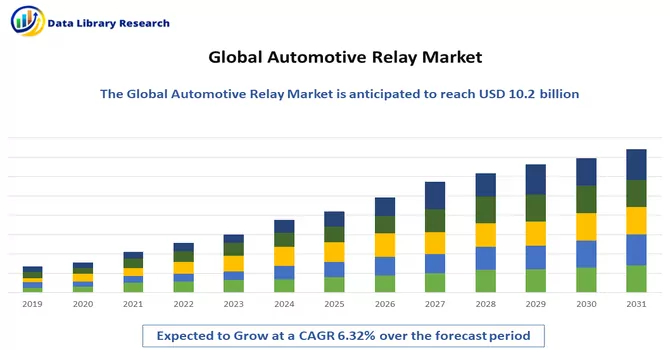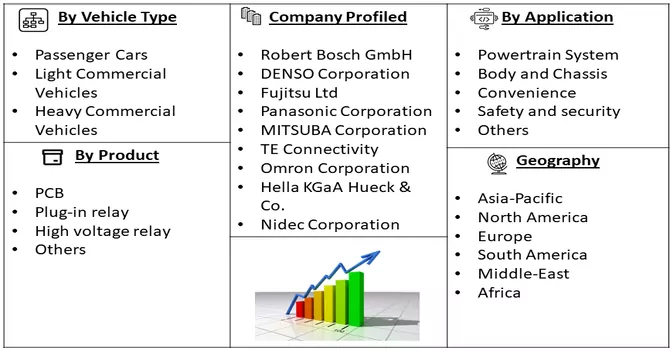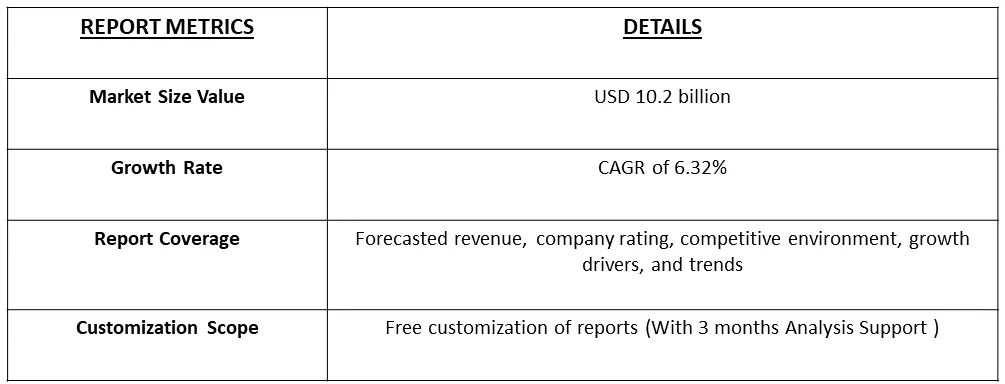The Automotive Relay Market size is expected to grow from USD 10.2 billion in 2023, registering a CAGR of 6.32% during the forecast period (2024-2031).

Get Complete Analysis Of The Report - Download Free Sample PDF
An automotive relay is an electromechanical or solid-state switch device commonly used in automotive electrical systems. Its primary function is to control electrical circuits by opening and closing contacts, allowing or interrupting the flow of electrical current. Relays play a crucial role in automotive, serving to manage high-current loads, protect delicate electronic components, and enable the efficient operation of various vehicle systems. Automotive relays are often employed in functions such as controlling headlights, power windows, fuel pumps, starter motors, and other electrical devices within a vehicle. They work by responding to a low-power input signal, typically from a switch or a control module, and act as an intermediary to control the higher-power circuit. This design helps isolate the low-power control circuit from the higher-power load circuit, ensuring the safety and reliability of the vehicle's electrical system. Automotive relays come in various types, including electromagnetic and solid-state relays, each suited to specific applications within the complex electrical architecture of modern vehicles.
The automotive relay market is experiencing robust growth, fueled by several key driving factors. Firstly, the pervasive trend of vehicle electrification, notably the increasing adoption of hybrid and electric vehicles, is a major catalyst. As vehicles become more electronically sophisticated, the demand for relays to manage and control various electrical systems continues to rise. Advanced Driver Assistance Systems (ADAS), including features like adaptive cruise control and lane departure warning systems, also contribute significantly to the market's expansion, relying on relays to ensure precise management of sensors and actuators. Moreover, there is a growing emphasis on lightweight and high-performance relays due to the automotive industry's focus on improving fuel efficiency and reducing vehicle weight.
Market Segmentation: The Automotive Relay Market is segmented by type (PCB relay and plug-in relay), application type (locking system, engine management module, lamps/lights, and other application types (power window, sunroof, ABS control, etc.)), and geography (North America, Europe, Asia-Pacific, and rest of the world). The report offers market size and forecasts for all the above segments in value (USD).

For Detailed Market Segmentation - Download Free Sample PDF
The rising trend toward vehicle electrification, encompassing hybrid and electric vehicles, is a key factor propelling the demand for relays to effectively control and oversee diverse electrical systems. Additionally, the expansion of Advanced Driver Assistance Systems (ADAS), such as adaptive cruise control and lane departure warning systems, relies heavily on relays for the precise management of sensors and actuators. This surge in demand for relays is driving manufacturers to focus on the production of advanced variants with attributes like lightweight construction and high performance, leading to an increased emphasis on solid-state relays over conventional and heavier electromechanical relays. This shift in focus is particularly pronounced due to the growing popularity of hybrid and electric vehicles in the region, reflecting the industry's commitment to meeting the evolving needs of the automotive market.
Market Drivers:
Increasing Electrification of Vehicles
The increasing electrification of vehicles stands as a transformative trend in the automotive industry, significantly influencing the role and demand for automotive relays. With a growing emphasis on electric and hybrid vehicles, there is a substantial shift from traditional internal combustion engines to advanced electric propulsion systems. This transition necessitates intricate electrical architectures, sophisticated power distribution, and efficient control mechanisms, where automotive relays play a pivotal role. In electric vehicles (EVs) and hybrid electric vehicles (HEVs), relays are integral components that facilitate the smooth operation of various systems. They are crucial for managing power distribution, controlling charging and discharging processes in batteries, and overseeing the functions of electric drivetrains. Automotive relays in electric vehicles often contribute to the efficient operation of components like electric motors, power inverters, and charging systems, ensuring seamless integration and functioning within the complex electrical network. Moreover, the electrification trend has led to an increased focus on safety and reliability in vehicle design. Automotive relays, being essential for controlling high-voltage circuits, contribute to the safety and stability of electric and hybrid vehicles. They play a key role in isolating circuits, protecting components from overloads, and ensuring the proper functioning of critical systems.
Technological Advantages
The integration of solid-state technology in automotive relays has marked a significant advancement. Solid-state relays use semiconductor devices like transistors for switching instead of traditional mechanical contacts. This results in faster response times, increased durability, and a longer operational lifespan compared to electromechanical relays. Ongoing technological developments have led to the miniaturization of automotive relays. Smaller and more compact designs contribute to space optimization within vehicles, crucial in the context of the automotive industry's focus on lightweight and efficient use of space. Thus, technological advancements in automotive relays encompass a spectrum of improvements, ranging from the adoption of solid-state technology and miniaturization to the incorporation of smart features and enhanced communication capabilities. These advancements collectively contribute to the reliability, efficiency, and adaptability of automotive relays in the rapidly evolving landscape of vehicle electronics and electrical systems.
Market Restraints:
High-Cost
A Printed Circuit Board (PCB) relay is an essential component within electronic circuits, providing a crucial function in controlling the flow of electrical signals. These relays are specifically designed for integration onto printed circuit boards, allowing for compact and efficient arrangements of electronic components. PCB relays serve as electrically operated switches, enabling or interrupting the current flow within a circuit based on an external input, often from a control signal or a microcontroller. These relays are characterized by their compact size, which makes them well-suited for applications where space is limited, such as in various electronic devices and systems. PCB relays find extensive use in industries ranging from telecommunications and consumer electronics to automotive and industrial automation. One of the key advantages of PCB relays is their versatility in handling different voltage and current levels, making them adaptable to a wide range of applications. They play a pivotal role in controlling various electronic functions, including power distribution, signal routing, and the activation of different components within a circuit. PCB relays come in various configurations, such as single-pole single-throw (SPST), single-pole double-throw (SPDT), and double-pole double-throw (DPDT), offering flexibility in accommodating diverse circuit requirements. Thus, PCB relays are integral components in electronic circuits, providing a compact and efficient solution for controlling electrical signals on printed circuit boards. Their widespread application across various industries underscores their importance in the realm of electronics and technology.
COVID-19 Impact on Automotive Relay Market:
The COVID-19 pandemic had a profound impact on the automotive relay market, causing disruptions across the supply chain and production processes. The widespread lockdowns, restrictions, and economic uncertainties during the pandemic led to a significant decline in automotive manufacturing activities, thereby affecting the demand for relays. Production shutdowns and delays in the automotive sector, combined with challenges in the availability of raw materials and components, resulted in a temporary setback for relay suppliers. However, as the industry gradually rebounded with the easing of restrictions and increased vaccinations, there has been a recovery in automotive manufacturing and, consequently, in the demand for relays. The pandemic also accelerated certain industry trends, such as the emphasis on electric and hybrid vehicles, driving the need for relays in these advanced automotive technologies. Overall, while the initial impact of COVID-19 posed challenges to the automotive relay market, the sector is adapting to the evolving landscape and leveraging opportunities arising from shifts in consumer preferences and technological advancements.
Segmental Analysis:
PCB Relay Segment is Expected to Witness Significant Growth Over the Forecast Period
A PCB (Printed Circuit Board) relay is a compact and integral component in electronic systems, specifically designed for seamless integration onto printed circuit boards. These relays serve as electrically operated switches within electronic circuits, allowing for precise control of electrical signals. PCB relays are characterized by their space-efficient design, making them well-suited for applications where size constraints are critical, such as in consumer electronics, telecommunications, automotive systems, and industrial automation. Their versatility extends to various circuit configurations, including single-pole single-throw (SPST), single-pole double-throw (SPDT), and double-pole double-throw (DPDT), catering to diverse electronic requirements. The integration of PCB relays ensures efficient and reliable signal routing, power distribution, and component activation within electronic devices, contributing to the overall functionality and performance of electronic systems.
Engine Management Module Segment is Expected to Witness Significant Growth Over the Forecast Period
The Engine Management Module (EMM) and automotive relays are integral components in modern vehicles, working collaboratively to ensure the optimal functioning of the engine and related systems. The Engine Management Module, often referred to as the Engine Control Module (ECM) or Engine Control Unit (ECU), is a sophisticated electronic control unit responsible for overseeing and regulating various aspects of the engine's performance. It processes data from numerous sensors throughout the vehicle, adjusting parameters such as fuel injection, ignition timing, and air-fuel mixture to optimize efficiency, emissions, and overall engine operation. In this intricate engine control process, automotive relays play a crucial role. Relays act as electrically operated switches, controlling the flow of current to various components within the engine management system. For instance, relays are commonly employed in the control of fuel injectors, ignition systems, and other critical engine functions. They serve as intermediaries between the EMM and the high-current components, ensuring precise and reliable activation of these elements. Thus, the collaboration between the Engine Management Module and automotive relays contributes to the seamless operation of the engine, allowing for real-time adjustments based on driving conditions and ensuring optimal performance. This integration enhances fuel efficiency, reduces emissions, and contributes to the overall reliability of the vehicle. As automotive technology continues to advance, the synergy between the Engine Management Module and automotive relays remains crucial for achieving the intricate control and precision required in modern engine management systems.
Asia Pacific Region is Expected to Witness Significant Growth Over the Forecast Period
The Asia-Pacific region stands as the global epicentre for automotive production, boasting major automobile manufacturing countries such as China, Japan, South Korea, and India. This prominence is fueled by rising income levels, rapid urbanization, and improved living standards, culminating in a substantial increase in vehicle ownership across the region. The surge in vehicle ownership has a direct impact on the demand for automotive relays, integral components in various vehicle systems. Moreover, many countries in Asia-Pacific have implemented stringent emission regulations to combat pollution and reduce greenhouse gas emissions. These regulations are propelling the adoption of advanced engine management and emission control systems that rely on relays for efficient operation. A significant trend shaping the automotive industry in the region is the shift towards Electric Vehicles (EVs) and hybrid vehicles. Unlike traditional internal combustion engine vehicles, EVs and hybrids utilize a greater number of relays, contributing significantly to the market's growth. The evolving landscape sees relays becoming more compact and integrated, addressing the industry's focus on lightweighting and space optimization in vehicles. The Asia-Pacific region is at the forefront of the automotive relay market, driven by its pivotal role as a major automotive production hub, the steady growth in vehicle ownership, the electrification of vehicles, adherence to stringent regulations, and the widespread adoption of advanced automotive technologies. The region's multifaceted contributions underscore its leadership in shaping the dynamics of the global automotive relay market.

Get Complete Analysis Of The Report - Download Free Sample PDF
The automotive relay market is characterized by intense competition, attributed to the coexistence of international and domestic suppliers within the region. Both global and local relay providers are actively participating in the market, fostering a highly competitive landscape. These companies are making substantial investments in Research and Development (R&D) initiatives to stay at the forefront of technological advancements and to address the evolving needs of the automotive industry. The emphasis on R&D underscores the commitment of these relay suppliers to innovation and staying ahead of market trends. Additionally, the market witnesses a continuous influx of new products as companies strive to meet the dynamic demands of the automotive sector. The launch of innovative relay products contributes to differentiation strategies and allows companies to maintain a competitive edge in the rapidly evolving automotive relay market.
Recent Development:
1) In January 2023, Bosch unveiled ambitious plans to invest over USD 1 billion in the expansion of its e-mobility capacities in China. This substantial investment is anticipated to catalyze a heightened demand for automotive relays within the region, reflecting the industry's commitment to the growing electric mobility sector.
2) In May 2022, Taolink Technologies successfully secured USD 15 million through a Series A funding round, with Xinyi Capital leading the investment. Specializing in the development and provision of chips for narrowband communication devices, Taolink Technologies is actively engaged in the creation of System-on-Chips (SoCs), relays, gateways, and various components applied across diverse industry sectors, including automotive and communication. This strategic funding is poised to facilitate the company's continued innovation and expansion within the automotive and communication industries and beyond.
Q1. What was the Automotive Relay Market size in 2023?
As per Data Library Research the Automotive Relay Market size is expected to grow from USD 10.2 billion in 2023.
Q2. At what CAGR is the Automotive Relay Market projected to grow within the forecast period?
Automotive Relay Market is registering a CAGR of 6.32% during the forecast period.
Q3. What are the factors driving the Automotive Relay market?
Key factors that are driving the growth include the Increasing Electrification of Vehicles and Technological Advantages.
Q4. Which region has the largest share of the Automotive Relay market? What are the largest region's market size and growth rate?
Asia-Pacific has the largest share of the market . For detailed insights on the largest region's market size and growth rate request a sample here.
Data Library Research are conducted by industry experts who offer insight on industry structure, market segmentations technology assessment and competitive landscape (CL), and penetration, as well as on emerging trends. Their analysis is based on primary interviews (~ 80%) and secondary research (~ 20%) as well as years of professional expertise in their respective industries. Adding to this, by analysing historical trends and current market positions, our analysts predict where the market will be headed for the next five years. Furthermore, the varying trends of segment & categories geographically presented are also studied and the estimated based on the primary & secondary research.
In this particular report from the supply side Data Library Research has conducted primary surveys (interviews) with the key level executives (VP, CEO’s, Marketing Director, Business Development Manager and SOFT) of the companies that active & prominent as well as the midsized organization
FIGURE 1: DLR RESEARH PROCESS

Extensive primary research was conducted to gain a deeper insight of the market and industry performance. The analysis is based on both primary and secondary research as well as years of professional expertise in the respective industries.
In addition to analysing current and historical trends, our analysts predict where the market is headed over the next five years.
It varies by segment for these categories geographically presented in the list of market tables. Speaking about this particular report we have conducted primary surveys (interviews) with the key level executives (VP, CEO’s, Marketing Director, Business Development Manager and many more) of the major players active in the market.
Secondary ResearchSecondary research was mainly used to collect and identify information useful for the extensive, technical, market-oriented, and Friend’s study of the Global Extra Neutral Alcohol. It was also used to obtain key information about major players, market classification and segmentation according to the industry trends, geographical markets, and developments related to the market and technology perspectives. For this study, analysts have gathered information from various credible sources, such as annual reports, sec filings, journals, white papers, SOFT presentations, and company web sites.
Market Size EstimationBoth, top-down and bottom-up approaches were used to estimate and validate the size of the Global market and to estimate the size of various other dependent submarkets in the overall Extra Neutral Alcohol. The key players in the market were identified through secondary research and their market contributions in the respective geographies were determined through primary and secondary research.
Forecast Model
